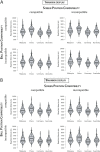What Simon "knows" about cultural differences: The influence of cultural orientation and traffic directionality on spatial compatibility effects
- PMID: 36180770
- PMCID: PMC9992257
- DOI: 10.3758/s13421-022-01360-9
What Simon "knows" about cultural differences: The influence of cultural orientation and traffic directionality on spatial compatibility effects
Abstract
Previous research has suggested that culture influences perception and attention. These studies have typically involved comparisons of Westerners with East Asians, motivated by assumed differences in the cultures' self-concept or position on the individualism-collectivism spectrum. However, other potentially important sources of cultural variance have been neglected, such as differences in traffic directionality shaped by the urban spatial environment (i.e., left-hand vs. right-hand traffic). Thus, existing research may potentially place too much emphasis on self-concepts or the individualism-collectivism dimension in explaining observed cultural differences in cognition. The present study investigated spatial cognition using a Simon task and tested participants from four nations (Australia, China, Germany, and Malaysia) that differ in both cultural orientation (collectivistic vs. individualistic) and traffic directionality (left-hand vs. right-hand traffic). The task used two possible reference frames underlying the Simon effect: a body-centered one based on global stimulus position relative to the screen's center versus an object-centered one based on local stimulus position relative to a context object. As expected, all groups showed a reliable Simon effect for both spatial reference frames. However, the global Simon effect was larger in participants from countries with left-hand traffic. In contrast, the local Simon effect was modulated by differences in cultural orientation, with larger effects in participants from collectivistic cultures. This pattern suggests that both sources of cultural variation, viz. cultural orientation and traffic directionality, contribute to differences in spatial cognition in distinct ways.
Keywords: Cultural orientation; Culture; Simon effect; Spatial cognition; Spatial compatibility; Spatial reference frames; Traffic directionality.
© 2022. The Author(s).
Conflict of interest statement
The authors declare that the research was conducted in absence of any commercial or financial relationship that could be construed as a potential conflict of interest. There are no conflicts of interest in the conduct and reporting of research described in this article. Research reported in this article has been presented as a poster at the 61th Tagung experimentell arbeitender Psychologen (TeaP) under the title “Cultural influences on spatial cognition: Evidence from egocentric and allocentric Simon Effects” and at the 61th Meeting of the Psychonomic Society under the title “When spatial compatibility meets different self-concepts: Differences in the Simon Effect across cultures”.
Figures



References
-
- Baess P, Bermeitinger C. More than 1 Simon: Evidence for multiple spatial and non-spatial reference frames. Manuscript submitted for publication; 2022.
-
- Baess, P., Bermeitinger, C., & Jänig, J. (2022). On the influence of perceptual factors on automatic response activation: Evidence from the Simon task. Manuscript submitted for publication.
-
- Bates DM, Maechler M, Bolker BM, Walker SC. Fitting linear mixed-effects models using lme4. Journal of Statistical Software. 2015;67(1):1–48. doi: 10.18637/jss.v067.i01. - DOI
Publication types
MeSH terms
LinkOut - more resources
Full Text Sources
Research Materials

